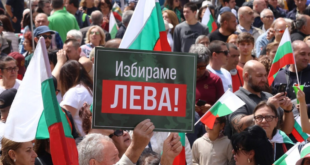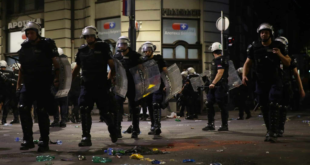A BIRN data analysis shows that Albania’s ruling Socialists dominated the social media campaign before the country’s last parliamentary election. Experts worry about the effect on public debate and democracy.
The crowd cheered and online viewers held their breath as the plane glided in to land at the Zayed-North Wings Airport in the northeastern Albanian city of Kukes, close to the border with Kosovo.
The Air Albania Airbus A319 came to a stop to music blasting from loudspeakers; airport workers rolled out a red carpet and the country’s prime minister, Edi Rama, stepped from the plane in a black coat, sweatpants, t-shirt and white sneakers escorting two fellow passengers, a woman and her young daughter.
It was an entrance worthy of a Hollywood A-lister more than a politician running for re-election.
“Politicians have turned into influencers and they compete for attention with prominent actors or famous bloggers,” said Blendi Salaj, a media analyst and morning host at local CNN-affiliate A2 TV. “They post constantly to attract attention, to generate engagement, but not necessarily to communicate their political message.”
The flight was the first to the Kukes airport, which is still under construction. But it was Rama who stole the show, broadcasting the carefully-choreographed video live on his Facebook page. It was viewed more than 1.6 million times, making it the social media post that garnered the most interaction from any candidate running in the April 25 election.
Amid strict COVID-19 restrictions, social media more than ever became an essential tool of communication for parties and individual candidates during the election. And it was Rama’s winning Socialist Party that was most active, according to a data analysis by BIRN.
In the race to influence as many voters online as possible, there were a total of 25,000 posts on the 298 Facebook pages of election candidates between March 26 and the eve of the vote, April 24, or an average of 819 per day.
Using Crowdtangle, a social media analysis application owned by Facebook, BIRN found that candidates of the ruling Socialist Party had more social media interaction with their followers than their rivals from the opposition centre-right Democratic Party.
The social media pages of Socialist Party candidates registered 9.72 million combined interactions on Facebook during the election campaign, followed by the Democrats with 8.76 million interactions and the Socialist Movement for Integration with 576,333.
On Instagram, the Socialists were again ahead, with 2.6 million combined interactions, followed by Democrat candidates with 1.79 million and candidates of the Socialist Movement for Integration with 270,099.
“If you look at how they post and what they post, you see a very professional commitment to [producing] videos, graphics, photography,” Salaj told BIRN.
“Politicians have removed their professional gowns and turned into sort of animators in society.”
Party leaders strengthened
Rama secured a third successive term in office in the April election, with his party taking 48.86 per cent of the vote, or 74 of the 140 seats in parliament. The Democrats took 59 seats, following by the Socialist Movement for Integration with four.
In its analysis, BIRN reviewed more than 756 Facebook and Instagram accounts in total, including party pages and pages held by local branches of the three biggest political parties participating in the election.
While the rate of combined interactions of a candidate does not necessarily translate into votes, it does give a good indication of the effectiveness of a candidate’s messaging. The analysis does not include private accounts or closed groups.
Data from Crowdtangle shows that during the 30-day campaign, the combined 298 Facebook pages generated a total of 19.22 million interactions on Facebook and 167.64 million views of live streams and video posts.
Roughly a third of the interactions on Facebook were generated by the leaders of the two biggest parties, Rama and Democratic Party leader Lulzim Basha.
Rama registered 4.7 million interactions on Facebook, or 25 per cent of the total of all candidates, while Basha registered nearly 2.1 million interactions or 11 per cent of the total.
Together, Basha and Rama registered 46 per cent of the total 167.64 million video views during the election campaign. Rama had 56.4 million video views, or 34 per cent of the total, while Basha had 21.3 million views, or 13 per cent.
“Social media helped strengthen the hold of political leaders on their respective parties, compared with other candidates, because party structures were instructed to share their leader’s posts and those he favoured,” said Afrim Krasniqi, executive director of the Institute of Political Studies in Tirana.
Rama also dominated on Instagram, with 1.08 million interactions or 23 per cent of the total 4.78 million interactions for all candidates.
But on this platform, Basha was outdone by his Democratic Party ally Ori Nebiaj, a popular TV host who ran for parliament and registered 511,889 interactions, more than the 307,112 of her party leader.
But those who enjoyed the most success online did not necessarily secure the most support at the ballot box.
“In the SP [Socialist Party], the MPs with the most votes were the candidates with massive online campaigns, while, with a few exceptions, the same was true of the DP [Democratic Party],” said Krasniqi, who noted too that new political parties with sizable online followings actually fared badly in the election.
“The online campaign helped parties and candidates mainly in urban areas and among the tech-user generation, leaving the fringe areas uninformed and easily accessible to rich individuals with the capacity to buy votes,” he told BIRN.
As for the Facebook pages of the 17 political parties, these earned 701,150 interactions, nearly half on the pages of the Socialist Party. The Socialists also enjoyed roughly 65 per cent of the 13.68 million video views on political party Facebook pages, compared to the Democratic Party’s 24 per cent.
‘Threat to democracy’
Krasniqi said the social media campaign did not make candidates more accessible. On the contrary, it allowed them to avoid the scrutiny of journalists and control the narrative.
“It minimised the importance of electoral programmes and strengthened the importance of visual elements and advertising,” he said.
“The online campaign also weakened the role of the media during the campaign and the weight of news reporting and journalists.”
Koloreto Cukali, head of the Albania Media Council, agreed, saying that the domination of social media wiped out the role of news reporters.
“By erasing the journalists the politicians removed the character who is there to ask the hard questions,” he said. “By removing the role of the journalist, an attempt was made to link politicians directly to voters through social media.”
Constructive debate is almost a thing of the past on social media, said Salaj, with critical comment only attracting online attacks.
The way politicians are using social media has become corrosive for democracy, he argued.
“I want to believe that they cannot dominate social media with money, but in a moment like this, when large amounts of cash are thrown about, they can distort public debate,” Salaj told BIRN.
“Social media, in the way they function, in the way they accept money or draw more attention to certain characters, can be a threat to democracy.”
 Eurasia Press & News
Eurasia Press & News



